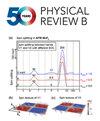Quadratic optical response to a magnetic field in the layered magnet CrSBr
IF 3.7
2区 物理与天体物理
Q1 Physics and Astronomy
引用次数: 0
Abstract
The optical properties of layered materials are dominated by intralayer excitons; especially for layered antiferromagnets the layer-to-layer charge hopping, and therefore interlayer excitons, are spin forbidden. An external magnetic field, however, can continuously drive the magnetic order towards layer-to-layer ferromagnetic, which opens spin-allowed charge-transfer channels between the layers. Here, we elaborate how their admixture changes the composition and nature of the excitons, leading to an extension over many layers, and causing a quadratic redshift with respect to the external magnetic field in CrSBr. We present a minimal four-band model to elucidate the interplay between the various interaction and coupling mechanisms which is able to reproduce the findings of our GW–Bethe-Salpeter equation calculations as a function of magnetic field. Our model is generally valid for any coupled layers with different spin directions and the insights help to systematically address excitons and to predict their optical signatures in such systems.求助全文
约1分钟内获得全文
求助全文
来源期刊

Physical Review B
物理-物理:凝聚态物理
CiteScore
6.70
自引率
32.40%
发文量
0
审稿时长
3.0 months
期刊介绍:
Physical Review B (PRB) is the world’s largest dedicated physics journal, publishing approximately 100 new, high-quality papers each week. The most highly cited journal in condensed matter physics, PRB provides outstanding depth and breadth of coverage, combined with unrivaled context and background for ongoing research by scientists worldwide.
PRB covers the full range of condensed matter, materials physics, and related subfields, including:
-Structure and phase transitions
-Ferroelectrics and multiferroics
-Disordered systems and alloys
-Magnetism
-Superconductivity
-Electronic structure, photonics, and metamaterials
-Semiconductors and mesoscopic systems
-Surfaces, nanoscience, and two-dimensional materials
-Topological states of matter
 求助内容:
求助内容: 应助结果提醒方式:
应助结果提醒方式:


